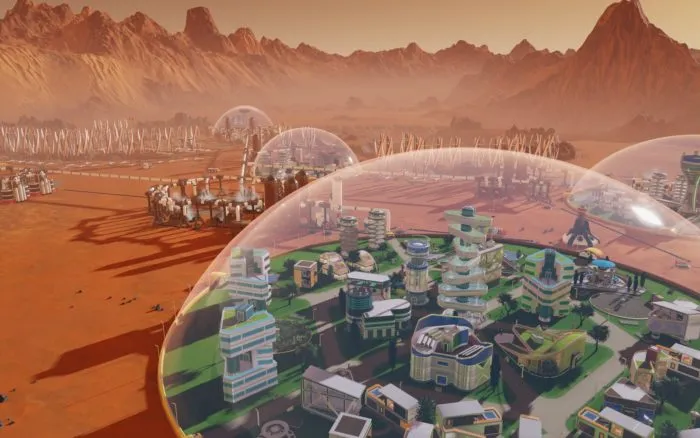Surviving Mars on PC
Surviving Mars, the latest and greatest from Haemimont Games and Paradox Interactive, is what I imagine Mars is like in real life: uninviting and brutal. There’s very little hand holding, and the game doesn’t do a great job of explaining what is going on a lot of the time. However, if you can get over the steep learning curve, Surviving Mars is an incredibly rewarding and compelling game.
Right off the bat, Surviving Mars, despite what the multi-platform release might suggest, is definitely for the hardcore strategy and simulation game fan. Anyone stumbling onto this game expecting something casual along the lines of The Sims, and dare I say even Civilization, is going to be overwhelmed pretty fast. It’s not rocket science, and you can certainly learn to play Surviving Mars properly, it’s just not very friendly to inexperienced players in the genre. You drop in with very little guidance, and the few suggestions you get from the game are basic and not always applicable for what you’re trying to do. All you really know is that this is a game about putting humans on Mars, and your goal, more or less, is to figure out how to do that safely.
At first you begin with rovers, which are there to get the basic resources you need to even dream of having a human colony up and running. They can build machines that automatically gather concrete, tap into natural resources, and construct buildings that can collect the basic necessities for life, oxygen, and water.
This early part of the game is very slow. You’re very limited to what you can build (well, useful buildings anyway). If you’re playing with a randomly generated map, you’re also at the mercy of whatever natural resources happen to be nearby. In one of my games, I started near the most basic of resources, concrete and metal (the latter which I couldn’t mine right away without humans anyway)… and that’s about it. The nearest water deposits were in a basin far away from me, and it wasn’t possible to pipe it over due to the terrain. I had to make do with what I had around me, and get water through collecting moisture, which is a slower, and more costly process. The game before humans start showing up can be a bit dull, and getting dragged down by bad RNG can make it that much duller.
That randomness also carries into other parts of the game such as the research tree. Not everything you can research will always be in the same order, which is a bit strange. By design, Surviving Mars wants each game to feel different than the last, and intentionally mixes in a dose of random elements. You can mitigate that somewhat by creating your own custom games (and likely mods as well), but it certainly nudges you in the direction of just letting the pieces fall where they may, and leaving it up to you how to best put everything back together. While this can be an annoyance for some, overall this is a design choice that succeeds in spicing up a new game from your last.

On the other hand, I appreciated the variety of different locations you can spawn in, and the challenges that come with getting a not so easy starting position or further away from useful things like potentially advantageous anomalies that can be researched or key resources.
The key I found for just plowing through this sometimes less-fun early game was just to make heavy use of the fast forward button. The game moves at a snail’s pace by default. The only time I kept the speed at anything other than max speed is when I needed to micromanage a time sensitive problem. Thankfully that option is there, because if it wasn’t, the game would be unplayable to all but the most patient of players.
When the game goes wrong early on, it can go very wrong. In my first game, because things are poorly explained, I reached a point where I was out of resources and couldn’t understand why my drones wouldn’t respond to my commands. It turns out that what I needed to do was resupply critical resources I couldn’t yet obtain, from Earth, using a rocket I didn’t realize was re-launchable for a while. Without any resources to work with, drones will simply just not do anything and not really tell you why. By the time I had realized what was going on, my colony was in such a sad state of affairs that I just decided to start over. I have the stomach for this trial and error, but not everyone will, and not everyone wants to read through an encyclopedia of information in-game to figure things out.
Once you’ve fast forwarded your way past the slow early game and built up your colony to the point where you’re ready to start inviting humans, that’s where Surviving Mars really starts to take off. Humans are very fragile outside of Earth, and your first colony will test the foundation you created with your drones in the first stage of the game. You essentially work to build a crib from scratch, and you’ll quickly find out if it holds or not.
Events outside of your control will test how well your colony is put together. For example, pipe and cables can be faulty, and if you don’t have enough backup resources, your dome, which shelters your humans colonists, will quickly become inhospitable. Going back to one of my games where I lacked any nearby natural water: Water Vaporators need to be resupplied from Earth, so unless I wanted to be super patient (I didn’t want to be), I’d be limited to how many I can have going at once. I had just enough water to support my first dome. Every time a pipe would get faulty, or I had a power shortage, I would hold my breath that my drones could get everything back up and running in time before people started dying off. Although I was successful, the stress of being without air and water so constantly eventually led the sanity of my colonists to be reduced, causing a few of them to snap, reducing their productivity.
When you have only 12 or so colonists to start out, having just one person not on board could mean something critical, like a farm, not being run properly. And yes, you can get really into the nitty gritty of each individual colonist’s personality.

When you recruit colonists from Earth, you can be selective about who you send over. You can decide what professions you want (botanists and scientists, for example), and everyone has positive and negative traits that might make them more or less suitable for what you’re trying to accomplish. For example, a colonist could have traits that make them an excellent worker, but only if they are in a small colony of under 30 people (a loner). Micromanaging who you recruit, and where you place them for work is very important for quick success.
You also need to consider what the purpose of each dome colony will be. Just having humans live on Mars isn’t enough (as cool as that is). While your first dome might just be testing your ability to survive – and you actually need to survive for at least 10 days before Earth is convinced that they can safely send you more colonists – you’ll start figuring out what the point of all this will be long term as well. You have a lot of funding to start, but will eventually run out. You’ll want to set up domes near valuable resources that can be mined out and sent back to Earth in return for more funding.
Going back to the example of my resource starved game: although I couldn’t port the basin’s water over to my other domes and it wasn’t near any valuable ($$$) resources, I decided to use all the water I had there to make a well-supplied dome that pulled its weight by helping to construct and supply advanced resources that could be shipped to my other more profitable domes. Seeing a long term plan come together in that way is one of the joys of Surviving Mars.
Ultimately Surviving Mars is a fantastic simulation and strategy game. Again, it might be off-putting inexperienced players, and advanced players will likely need to find their own fun in the long term by creating obstacles for themselves to overcome or to seek out mods, lest it gets repetitive. Those small, potentially limiting gripes aside, Surviving Mars is a very enjoyable sim game that effectively mashes together individual sim micromanagement with larger macro concepts seen in games like RTSs. Any veterans of either genre looking for something in a Martian setting or something off the beaten path should definitely enjoy Surviving Mars.
Score: 4/5 – Great
Pros
| Cons
|
For more information on how we review games, check out Twinfinite’s review policy here.





Published: Mar 15, 2018 09:00 am